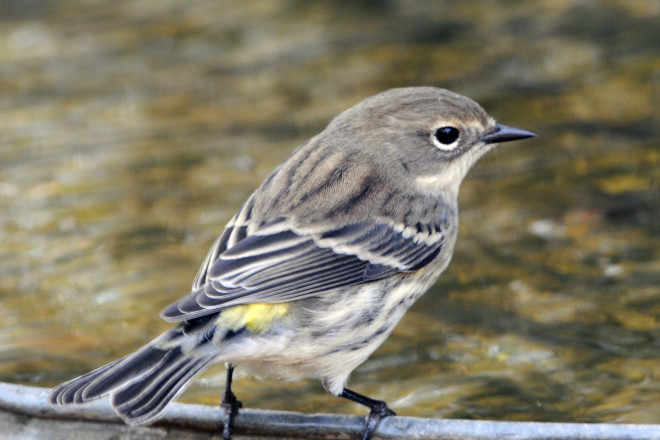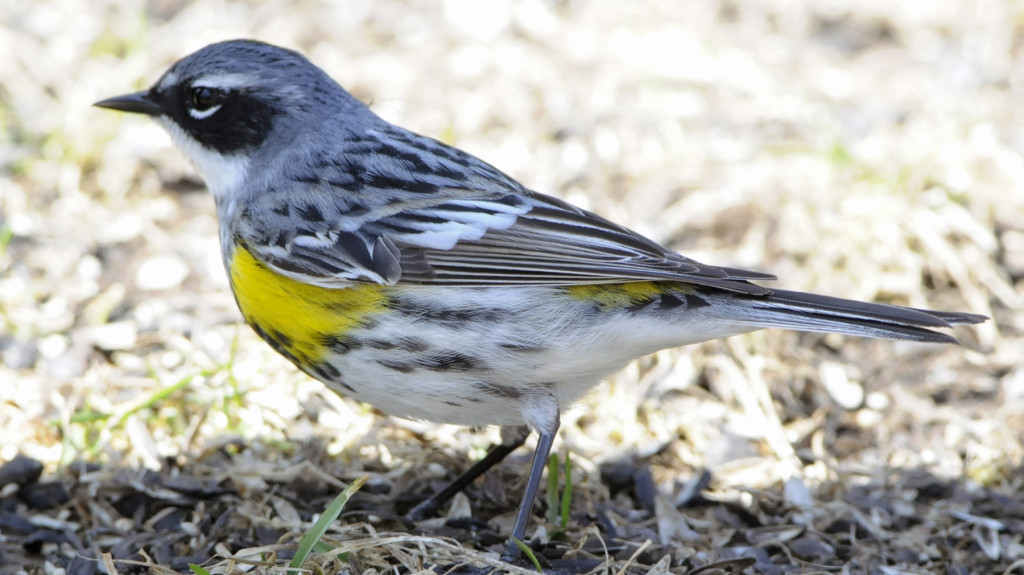Sparrow Like Bird With Yellow Spot on Back

A Yellow-rumped Warbler visits the bird bath in autumn showing more subdued colors than during the spring breeding season. Photo by Roy Lukes.
A migratory wave of tiny birds is moving through northeastern Wisconsin, reaching its peak in mid-October. Quite a few people who report them will catch glimpses of white outer tail feathers and will report them as northern juncos. A closer look would have revealed a yellow patch at the upper base of the tail. They will be Yellow-rumped Warblers, and chances are there will be thousands of them.
Years ago this comparatively large wood warbler was called either the Yellow-rump or Yellow-rumped Warbler. Gradually people along the East Coast, perhaps its primary migratory route, realized that these birds consumed great quantities of Myrtle berries, and the name Myrtle Warbler was established.
The plant genus, Myrica (Meer-i-ca), includes among others the Bayberry, Wax-myrtle, and Evergreen Bayberry. All bear small clusters of waxy-coated fruit much sought after by the Myrtle Warblers as well as candle makers. Our northeastern Wisconsin species, the Sweet Gale (Myrica gale), does not produce these berries but like the other species does have very aromatic leaves.
When the first sizeable change of common bird names was announced in 1973 by the American Ornithological Union, included was the Myrtle Warbler, now to be called the Yellow-rumped Warbler again. Admittedly the bird's yellow rump surely is an excellent field mark during all seasons. In fact this is one of the few of the 56 species of wood warblers in North America whereby both the adults and immature birds have such a highly visible "badge" of identification.
It is during the heavy invasion of Yellow-rumps that six or seven at a time will be vying for a turn at our dripping bird bath. However, as soon as a good rain comes along, the large puddles in our driveway seem to be preferred by these warblers along with others. The large ceramic bird bath on a pedestal goes begging.
Imagine our astonishment on Dec. 16, 1978, the first day of our Wisconsin Christmas Bird Count period that year, to have a Yellow-rumped Warbler in our backyard (at The Ridges then) feasting at the beef suet feeder. Fortunately I was able to document that record with a good photograph. Another Yellow-rump was seen two years later on the 1980 northern Door County bird count.
This conspicuous gentle bird winters farther north than any of the other wood warblers and is capable of sustaining itself for considerable periods of time by eating wild fruit and seeds. Records are reported annually of them wintering up to the southern limits of their breeding range. That includes the northernmost tier of counties in Wisconsin including Door County, and the entire Upper Peninsula of Michigan in this region.

Here is a male Yellow-rumped Warbler in his spring breeding plumage. Photo by Roy Lukes.
The striking blue-gray, black, white and yellow early summer breeding plumage of the adults changes to a much more subdued combination of colors in fall and winter. Now the majority are a gray-brown above, dull white to gray below with faint streaking, but all with the conspicuous yellow rump patch. We did notice a small number of specimens still retaining some of the characteristic adult plumage in part.
Another field mark on all of the birds is the noticeable white spots on each of the three outer tail feathers. In other words, six of the 12 tail feathers have the white spots, the largest white spot usually located on the outer-most tail feathers. These appear quite junco-like during flight and surely are highly visible white "tail lights" for others of their kind to be able to follow, similar in nature to the white tail "flag" of the White-tailed Deer.
Yellow-rumped Warblers eat a wide variety of foods, including berries, seeds and insects. The latter make up nearly their entire diet during the breeding season. Favorite berries include the Bayberry, Red Cedar, Poison Ivy, Poison Sumac, Virginia Creeper, Mountain Ash and many Dogwoods. Only the fleshy outer coverings of the Whitish Poison Ivy and Poison Sumac fruits are digested. The seeds are expelled in their droppings along with some fertilizer which surely must help in their germination. Quite obviously Poison Ivy is spread considerably by these and other birds, including the Downy Woodpecker.
I wonder if there is a direct relationship between what I feel is a rather common occurrence of Poison Ivy in shoreland areas and the fact that many of the Yellow-rumped Warblers follow coastlines during migration. The same potential phenomenon may apply to the vast quantities of Bayberry and Wax-myrtle along the Atlantic Ocean coast.
Yellow-rumps tend to congregate into sizeable but loosely-knit flocks during the fall and winter. In the past we have noticed particularly their sharp call notes, "CHEP" or "TURK," and the birds' tendency to turn sharply and flit their tails when landing, thereby displaying the white tail spots very clearly.
It is common for them to congregate with other birds during fall migration, birds such as the Palm Warblers, Dark-eyed Juncos and several of the sparrows including the Vesper and Field. In the past we were pleased to see a good number of Palm Warblers, easily told by their tail-bobbing habit, mingling with the "Myrtles."
Unfortunately tall buildings, radio and TV towers and large expanses of windows claim many Yellow-rumped Warbler lives especially during the fall migration. Two of these birds lay stunned on the ground recently in front of our passive solar collector. One flew away as soon as I nudged it with a finger. The other only moved a step or two ahead of my outstretched hand each time I approached it. I easily caught it gently and was surprised at the sharp tongue-lashing I received. "Tseet-tseet-tseet-tseet," which might have been interpreted as, "Get your big greasy hands off of my clean feathers!"
I placed the bird on the platform feeder where I could watch it from a distance. Fortunately it was back to normal in several minutes and flew away to join its yellow-rumped relatives in surely what had to be one of the most spectacular congregations of their kind in eastern Wisconsin in recent years. We wish them well on their southward journey!
Sparrow Like Bird With Yellow Spot on Back
Source: https://doorcountypulse.com/roy-lukes-yellow-rumped-warbler/
0 Response to "Sparrow Like Bird With Yellow Spot on Back"
Post a Comment